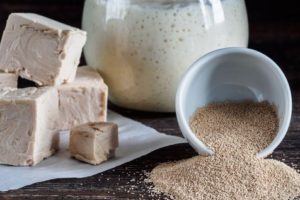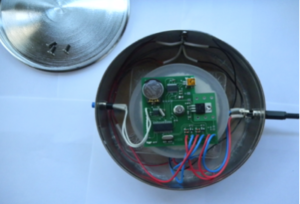Authors:
Shigina E.S., PhD student
Zakrepina E.N., Candidate of Vet.N., assoc., Vologda State Agricultural Academy, Vologda, Molochnoye village
S.Y. Tolmachev, Ph.D., Associate Professor, Corresponding Member of the Russian Academy of Sciences, International Institute Noospheric Technologies Moscow
Polyanskaya I.S.,Candidate of Technical Sciences, assoc., Vologda State Agricultural Academy, Vologda, Molochnoye village
 Yeast respiration is a complex process of biological oxidation. According to the type of respiration, yeast belongs to facultative anaerobes. The process of yeast respiration consists of a series of successive redox reactions between hydrogen cleaved from carboxylic acids in the tricarboxylic acid cycle and molecular oxygen. In the process of aerobic respiration, yeast, oxidizing one mole of glucose, receives energy equal to 2817 kJ, of which only 10-25% is used for their needs; the rest of the energy is released into the environment as heat. Therefore, the wort temperature at this stage is higher than the ambient temperature [1].
Yeast respiration is a complex process of biological oxidation. According to the type of respiration, yeast belongs to facultative anaerobes. The process of yeast respiration consists of a series of successive redox reactions between hydrogen cleaved from carboxylic acids in the tricarboxylic acid cycle and molecular oxygen. In the process of aerobic respiration, yeast, oxidizing one mole of glucose, receives energy equal to 2817 kJ, of which only 10-25% is used for their needs; the rest of the energy is released into the environment as heat. Therefore, the wort temperature at this stage is higher than the ambient temperature [1].
In anaerobic conditions, yeast receives energy due to oxygen-free respiration, i.e. fermentation. Alcoholic fermentation is one of the ways of anaerobic conversion of carbohydrates; in this case, glucose is almost completely broken down by yeast to ethyl alcohol and CO2 with the simultaneous accumulation of higher alcohols and other metabolic products and the release of a small part of energy. From an energy point of view, the process of aerobic oxidation of carbohydrates, i.e. respiration, is more advantageous, since almost 28 times less energy is released during fermentation. In yeast, the anaerobic conversion of glucose is an obligatory first stage, which can be followed by an aerobic phase — respiration, the intensity of which is directly dependent on the cultivation conditions [1].
The objective of the presented study was to study the effect of the Aquator device (photo 1,2) on the respiration and fermentation processes of Saccharomyces cerevisiae and Saccharomyces boulardii (a consortium of 4 mesophilic races of feed probiotic yeast).
The validity of using the device “Aquator” to control the process of yeast respiration follows from its functionality. The device belongs to the class of reprinters and is an instrumental tool that allows you to remotely transfer some properties of biologically active substances to water and aqueous solutions. Thus, using known stimulant substances or inhibitors, Aquator programs the environment to change the indicators of the phenomenon under study, in particular, to accelerate or slow down the process of yeast development in it.
There is information in the literature about the effective use of this technology in agriculture and in the processing of agricultural raw materials in the following practical aspects of application [2]:
plant growth stimulator;
stimulator of yeast development in winemaking;
an environmentally friendly means of combating agricultural pests and microorganisms of spoilage of agricultural products.
The technologies work at agricultural enterprises in South Africa, Hungary, Macedonia. Extensive work on the study of the applicability of technology at agricultural facilities was carried out at the Kuban State Agrarian University.
Represents the practical effect of economically feasible activation of the accumulation of feed probiotic yeast for farm animals on cheap secondary raw materials, in particular curd whey. In countries with a highly developed dairy industry, up to 90% of whey is used for the production of products and feed products. In Russia, its use is approximately 50% . One of the directions expanding the scope of use of dairy, in particular cottage cheese, whey is its fermentation by various types of probiotic microorganisms. When cultivating probiotics in serum as a nutrient medium, its initial composition is largely enriched with valuable metabolic products, such as enzymes, immune bodies, vitamins, organic acids, minerals in organic form, etc. [3]. In particular, on the basis of whey, the organization of the production of feed additives is relevant. Curd whey, as a medium for yeast nutrition, contains almost all the necessary substances. In particular, it is known that calcium plays the role of an activator in the microbial cell, is a cofactor of yeast transcetolase.
The increased content of calcium salts inhibits yeast reproduction, reduces the accumulation of glycogen in them and increases the content of sterols. So, with a content of Ca2 + up to 40 mg per 1 liter of medium, yeast reproduction is stimulated, with more it is suppressed. The calcium ions of natural whey completely cover the nutritional needs of yeast. Magnesium accelerates the consumption of sugars by yeast. Nutrient media should contain at least 0.02% magnesium ions for better yeast development, which is provided by magnesium contained in the serum by about 40%.
According to preliminary studies of the tested matrix for yeast in the laboratory of the International Institute of Noospheric Technologies, Moscow (S.Y. Tolmachev), its stimulating properties on the winter activity of fermenting thermophilic yeast were confirmed. Result: control/test — 65/76 units.
Further experiment was carried out in the laboratories of the Department of Milk and Dairy Products Technology, as well as the Department of Epizootology and Microbiology of the Vologda Dairy Academy. The course of the respiration process was judged by the change in the active acidity of the medium pH (+0.05 u pH) and the increment of yeast biomass (+ 0.5 108 CFU).
Conditions of the presented single-factor study: An oxygen-enriched nutrient medium based on curd whey containing an enriching dose of magnesium ions [4] was inoculated with 0.5% yeast starter culture placed in a water bath for 20 ° C (control), which was additionally installed on an Aquator device with a matrix of lyophilized concentrate “BifiLak”.


In the photo, the external and internal appearance of the industrial device “Aquator”
Table 1 — Study of the effect of the Aquator device on the active acidity during the growth of yeast biomass, unit pH
The matrix is a physical carrier on which information about the properties of the specified biologically active substance is pre-recorded. The device “Aquator” worked for the first 4.5 hours of the experiment. On the recommendation of the developer of Aquator, 10% sucrose was added to the curd whey at this stage of the experiment (experience and control were divided from a single combined sample). The biomass of yeast was 4.2 ۰108 by 6 hours of cultivation in the experimental sample, whereas in the control sample 2.2 ۰108 CFU/ cm3.
Thus, based on the research task and the selected experimental conditions, the following conclusion can be drawn: the “BifiLak” matrix somewhat stimulates the respiration process, and apparently does not work to stimulate the fermentation process.
Additional research is needed to select the optimal exposure time of the Aquator device and other factors of the effectiveness of its practical industrial application.
References and notes:
[1] Nudel L. Sh., Korotkevich A.V. Microbiology and biochemistry of wine. — Moscow, 2000.
[2] Vorobyev N.I., Matuzok N.V., Tolmachev S.Yu., Chaban A.I. Technology Activator – environmentally friendly technology of the new generation // Greenhouses of Russia. 2014. No. 2. pp. 57-61.
[3] Khramtsov A.G., Evdokimov I.A., Nesterenko P.G., Ryabtseva S.A. Treasure found: what should I do with it? // Dairy industry. 2013. — No. 6. — pp. 30-32.
[4] Polyanskaya I.S., Zakrepina E.N. Optimization of the composition of the nutrient medium for probiotics based on serum // Electronic scientific journal. — 2016. — № 2 (5). — Pp. 32-36.
© E.S. Shigina E.N. Zakrepina, S.Y. Tolmachev, 2018